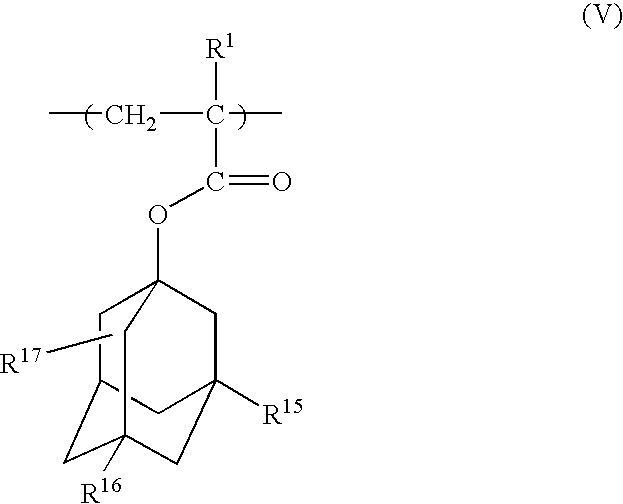Photoresist polymeric compound and photoresist resin composition
a polymer compound and resin technology, applied in the field of photoresist polymer compound and photoresist resin composition, can solve the problems of low adhesion to the substrate, and insufficient etching resistance of the overall polymer, etc., to achieve satisfactory transparency, good adhesion, and good adhesion.
- Summary
- Abstract
- Description
- Claims
- Application Information
AI Technical Summary
Benefits of technology
Problems solved by technology
Method used
Image
Examples
production example 1
Production of 1-Acryloyloxy-3-t-butoxycarbonyladamantane [1-1(Acrylate)]
Initially, 10 mmole of 1-adamantanol, 1 mmole of N-hydroxyphthalimide, 30 ml of acetic acid and 30 ml of 1,2-dichloroethane were placed in an autoclave, and were stirred at 95.degree. C. in a gaseous mixture atmosphere including 15 atm (=1.5 MPa) carbon monoxide and 1 atm (=0.1 MPa) air for 6 hours. The resulting reaction mixture was concentrated, and the concentrate was then subjected to column chromatography on a silica gel to thereby yield 1-carboxy-3-hydroxyadamantane in a yield of 47%.
A total of 25 mmole of acrylyl chloride (acryloyl chloride) was added dropwise to a mixture containing 10 mmole of 1-carboxy-3-hydroxyadamantane thus obtained, 25 mmole of triethylamine and 40 ml of tetrahydrofuran over about 30 minutes. After the completion of addition, the resulting mixture was stirred at room temperature for 2 hours. After adding water, the reaction mixture was extracted with ethyl acetate, and the organic ...
production example 2
Production of 1-t-Butoxycarbonyl-3-methacryloyloxyadamantane [1-1(Methacrylate)]
The title compound was obtained in the same manner as in Production Example 1, except that methacrylyl chloride (methacryloyl chloride) was used instead of acrylyl chloride.
.sup.1 H-NMR (500 MHz, CDCl.sub.3) .delta.: 1.45-1.63 (m, 6H), 1.92 (s, 3H), 2.00-2.19 (m, 7H), 2.30 (m, 2H), 5.52 (brs, 1H), 6.02 (brs, 1H).
production example 3
Production of 1-Acryloyloxy-3-t-butoxycarbonyl-5-hydroxyadamantane [1-3(Acrylate)]
The title compound was obtained in the same manner as in Production Example 1, except that 1,3-adamantanediol was used instead of 1-adamantanol to synthesis 1-carboxy-3,5-dihydroxyadamantane and that this compound was allowed to react with acrylyl chloride and then with isobutene.
.sup.1 H-NMR (500 MHz, CDCl.sub.3) .delta.: 1.43 (s, 9H), 1.60-2.22 (m, 12H), 2.38 (brs, 1H), 2.42 (m, 1H), 5.76 (dd, 1H), 6.03 (dd, 1H), 6.31 (dd, 1H).
PUM
| Property | Measurement | Unit |
|---|---|---|
| Fraction | aaaaa | aaaaa |
| Fraction | aaaaa | aaaaa |
| Percent by mass | aaaaa | aaaaa |
Abstract
Description
Claims
Application Information
 Login to View More
Login to View More - R&D
- Intellectual Property
- Life Sciences
- Materials
- Tech Scout
- Unparalleled Data Quality
- Higher Quality Content
- 60% Fewer Hallucinations
Browse by: Latest US Patents, China's latest patents, Technical Efficacy Thesaurus, Application Domain, Technology Topic, Popular Technical Reports.
© 2025 PatSnap. All rights reserved.Legal|Privacy policy|Modern Slavery Act Transparency Statement|Sitemap|About US| Contact US: help@patsnap.com



